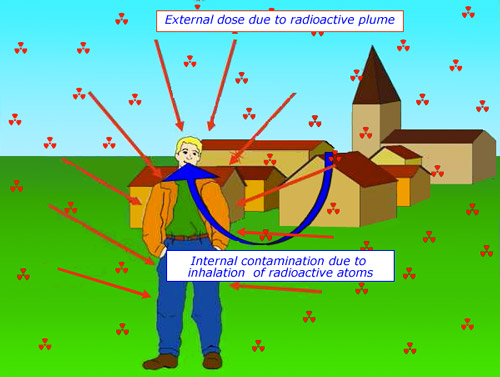Atmospheric radioactive pollution after a major accident
During a major accident, radioactive materials are released into the atmosphere either as a result of an explosion .or because beeing volatile they escape easily. Some radioelements, such as krypton-85 and xenon 133, are noble gases without chemical affinities. They will be diluted in the large volume of the atmosphere and would have little effect. Others would attach themselves to fine particles – aerosols – or of water vapor. The best known of them are iodine (iodine-131 and 132) and caesium (caesium-137 and 134) radioactive isotopes . These radioisotopes atoms wolld end up in a radioactive plume or cloud a that will travel and spread according to the winds and weather conditions

Air contaminated by dispersal of radioactivity
The presence of radioactive particles in the ambient air is source of external exposures and internal contaminations by inhalation. External exposurs are mainly due to gamma rays. Internal contamination is mostly due to alpha and beta rays. Radioactive particles in the air are mobile and their effect will last only the time of their passage. Unlike the ground deposits whose contamination lasts.
© IRSN
The radioactive particles of the plume emit radiation that could reach the ground and populations. They are the source of external exposure sdue to gamma rays since beta and especially alpha rays are stopped after a short range in air. The external exposure is transitory and lasts as long as the particles travel nearby. Also, if the particles are far enough from the ground and belong to a radioactive plume that traveled at high altitudes, radiation will be attenuated by distance and air shield effect.
This is how long-lived radioactive residues dispersed during nuclear tests in the 1960s, can be found in the troposphere and the stratosphere, where they circulate since then around the Earth without reaching us. Similarly, gamma rays can not wither flowers of a balcony in one night as was affirmed by a radio listener at the time of the passage of the Chernobyl cloud in France. The effects of gamma take much longer than one night to come forward … and wither flowers.
On the other hand radioactive particles present in the air. can be inhaled The dangers of the internal radiation resulting from inhalation can be much greater. The remedies are to wear masks, confine populations in homes and when possible filterthe air.

Contributions to exposures
According to the french radioprotection agency (IRSN ), food contamination was in 1986 the main source of exposure due to the Chernobyl accident in France, followed by ground deposits radiations. Exposures due to inhalation of radioactivity and radiations coming from radioactive particles in the air represented less than 10% (in the immediate vicinity of the accident, the proportions were higher). Twenty years later in 2006, the exposure doses have greatly decreased and are dominated by the ground deposits.
© Source : Livret IRSN Tchernobyl, 2006
Unlike exposure from ground depositions, exposure to radioactive atmospheric releases are by nature temporary. Shielding dispositions are mainly essential,during the pollution peaks. Later on as time is passing, the dilution and dispersion in the atmosphere, ground depositions on ground and on the wide surface of deep oceans, the decline of radioactive decays combine to reduce this exposure and the
Other articles on the subject « Accidental Releases »
Atomic bombs legacy
A legacy of the cold war The residue of radioactive contamination which still endures has its ori[...]
Risks of ground deposits
Two deposition modes: dry deposits and wet deposits In ordinary life, apart from the vicinity of [...]
Risks of Internal Exposure
After an accident : what impact on food and man ? A large amount of radioactivity was dispersed i[...]
Exposition modes (accident)
What are the exposition pathways after a major accident ? What is the impact on man of a major re[...]